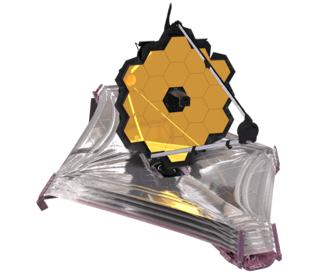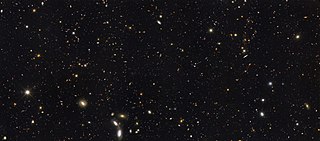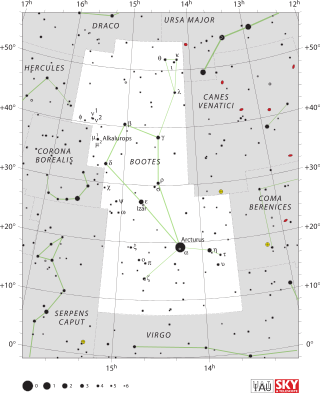
The James Webb Space Telescope (JWST) is a space telescope designed to conduct infrared astronomy. Its high-resolution and high-sensitivity instruments allow it to view objects too old, distant, or faint for the Hubble Space Telescope. This enables investigations across many fields of astronomy and cosmology, such as observation of the first stars and the formation of the first galaxies, and detailed atmospheric characterization of potentially habitable exoplanets.

The Great Observatories Origins Deep Survey, or GOODS, is an astronomical survey combining deep observations from three of NASA's Great Observatories: the Hubble Space Telescope, the Spitzer Space Telescope, and the Chandra X-ray Observatory, along with data from other space-based telescopes, such as XMM Newton, and some of the world's most powerful ground-based telescopes.

Lyman-break galaxies are star-forming galaxies at high redshift that are selected using the differing appearance of the galaxy in several imaging filters due to the position of the Lyman limit. The technique has primarily been used to select galaxies at redshifts of z = 3–4 using ultraviolet and optical filters, but progress in ultraviolet astronomy and in infrared astronomy has allowed the use of this technique at lower and higher redshifts using ultraviolet and near-infrared filters.

UDFy-38135539 is the Hubble Ultra Deep Field (UDF) identifier for a galaxy which was calculated as of October 2010 to have a light travel time of 13.1 billion years with a present proper distance of around 30 billion light-years.

UDFj-39546284 is a high-redshift Lyman-break galaxy discovered by the Hubble Space Telescope in infrared Hubble Ultra-Deep Field (HUDF) observations in 2009. The object, located in the Fornax constellation, was identified by G. Illingworth, R. Bouwens and the HUDF09 Team during 2009 and 2010. It was reported with a redshift of z~10 using Hubble and Spitzer Space Telescope photometric data, with later reports in 2012 suggesting a possibly higher redshift of z = 11.9 Although doubts were raised that this galaxy could instead be a low-redshift interloper with extreme spectral emission lines producing the appearance of a very high redshift source, later spectroscopic observations by the James Webb Space Telescope's NIRSpec instrument in 2022 confirmed the galaxy's high redshift to a spectroscopically confirmed estimate of z = 11.58.

MACS0647-JD is a galaxy with a redshift of about z = 10.7, equivalent to a light travel distance of 13.26 billion light-years. If the distance estimate is correct, it formed about 427 million years after the Big Bang.

GN-z11 is a high-redshift galaxy found in the constellation Ursa Major. It is among the farthest known galaxies from Earth ever discovered. The 2015 discovery was published in a 2016 paper headed by Pascal Oesch and Gabriel Brammer. Up until the discovery of JADES-GS-z13-0 in 2022 by the James Webb Space Telescope, GN-z11 was the oldest and most distant known galaxy yet identified in the observable universe, having a spectroscopic redshift of z = 10.957, which corresponds to a proper distance of approximately 32 billion light-years. Data published in 2024 established that the galaxy contains the most distant, and therefore earliest, black hole known in the universe, estimated at around 1.6 million solar masses.

SPT0418-47 is a gravitationally lensed, high-redshift, dusty star-forming galaxy, discovered with the South Pole Telescope. Observations with NASA's James Webb Space Telescope (JWST) have revealed the presence of a companion galaxy, which may indicate that SPT0418-47 is a merging system of galaxies. In June 2023 detection of organic molecules in SPT0418-47 using the Webb telescope was announced.

HD1 is a proposed high-redshift galaxy, which is considered to be one of the earliest and most distant known galaxies yet identified in the observable universe. The galaxy, with an estimated redshift of approximately z = 13.27, is seen as it was about 324 million years after the Big Bang, which was 13.787 billion years ago. It has a light-travel distance of 13.463 billion light-years from Earth, and, due to the expansion of the universe, a present proper distance of 33.288 billion light-years.

Webb's First Deep Field is the first operational image taken by the James Webb Space Telescope (JWST). The deep-field photograph, which covers a tiny area of sky visible from the Southern Hemisphere, is centered on SMACS 0723, a galaxy cluster in the constellation of Volans. Thousands of galaxies are visible in the image, some as old as 13 billion years. It is the highest-resolution image of the early universe ever taken. Captured by the telescope's Near-Infrared Camera (NIRCam), the image was revealed to the public by NASA on 11 July 2022.

GLASS-z12 is a Lyman-break galaxy discovered by the Grism Lens-Amplified Survey from Space (GLASS) observing program using the James Webb Space Telescope's NIRCam in July 2022. Spectroscopic observations of GLASS-z12 by the Atacama Large Millimeter Array (ALMA) in August 2022 confirmed that the galaxy has a spectroscopic redshift of 12.117±0.012, making it one of the earliest and most distant galaxies ever discovered, dating back to just 350 million years after the Big Bang, 13.6 billion years ago. ALMA observations detected an emission line associated with doubly ionized oxygen at 258.7 GHz with a significance of 5σ, suggesting that there is very low dust content in GLASS-z12, if not the early universe as well. Also based on oxygen-related measurements, the age of the galaxy is confirmed.

CEERS-93316 is a high-redshift galaxy with a spectroscopic redshift z=4.9. Significantly, the redshift that was initially reported was photometric and would have made CEERS-93316 the earliest and most distant known galaxy observed.
F200DB-045 is a candidate high-redshift galaxy, with an estimated redshift of approximately z = 20.4, corresponding to 168 million years after the Big Bang. If confirmed, it would be one of the earliest and most distant known galaxies observed.

Maisie's Galaxy is a distant galaxy located at z=11.4 that existed 390 million years after the beginning of the universe.

JADES-GS-z7-01-QU is a Lyman-break galaxy, first identified in 2010, located in the constellation Fornax. It formed around 700 million years after the birth of the universe, after which it suddenly stopped creating new stars. It experienced rapid star formation around 80 million years before the epoch of observation, lasting for at least 30 million years, before ending around 10-20 million years before the epoch of observation. It is the oldest and most distant "dead" galaxy so far discovered.

UNCOVER-z13 is a high-redshift Lyman-break galaxy discovered by the James Webb Space Telescope (JWST) during NIRCam imaging for the JWST Ultradeep NIRSpec and NIRCam Observations before the Epoch of Reionization (UNCOVER) project on November 14, 2023. UNCOVER-z13 is within Abell 2744 supercluster in the constellation Sculptor.

JADES-GS-z14-0 is a high-redshift Lyman-Break galaxy in the constellation Fornax that was discovered in 2024 using NIRcam as part of the JWST Advanced Deep Extragalactic Survey (JADES) program. It has a redshift of 14.32, making it the furthest galaxy ever discovered.

UNCOVER-z12 is a high-redshift Lyman-break galaxy discovered by the James Webb Space Telescope (JWST) during NIRCam imaging for the JWST Ultradeep NIRSpec and NIRCam Observations before the Epoch of Reionization (UNCOVER) project in November 2023. UNCOVER-z12 is within the Abell 2744 supercluster in the constellation Sculptor. It is the 5th-most distant object ever discovered as of 2024, and is estimated to be 32.21 giga-lightyears from Earth.




















